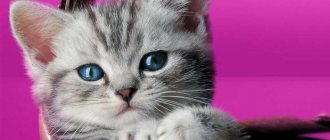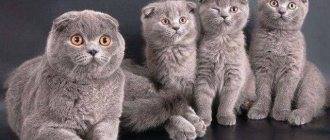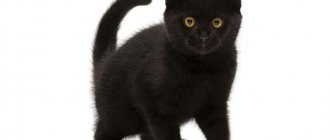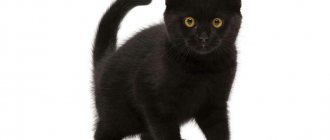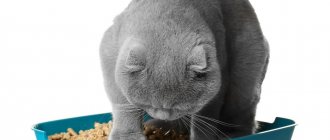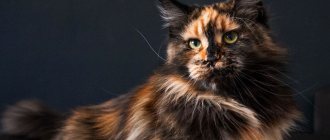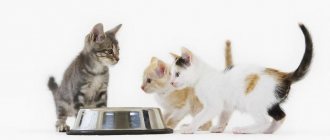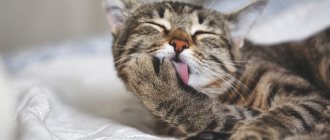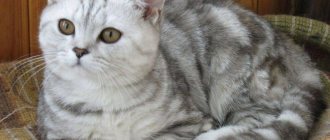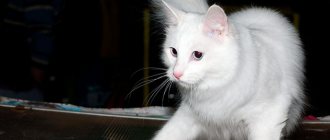The Whiskas color does not exist in nature, but it was this color that suddenly became viral and broke all records on the Internet for targeted queries about cats. There are up to fifty known and not very common breeds that claim to match the characteristics of appearance and coat. They have different histories and personalities, sizes and health, but the color of the coat and the pattern on it unite the cats into a common group worthy of a detailed description.
What can I do to prevent this in the future?
If you are on a personal connection, like at home, you can run an anti-virus scan on your device to make sure it is not infected with malware.
If you are at an office or shared network, you can ask the network administrator to run a scan across the network looking for misconfigured or infected devices.
Another way to prevent getting this page in the future is to use Privacy Pass. You may need to download version 2.0 now from the Chrome Web Store.
Cloudflare Ray ID: 568604f10883c85f • Your IP: 5.45.65.94 • Performance & security by Cloudflare
In the advertising video presenting Whiskas cat food, you can see a beautiful cat with a bright and memorable color - a brindle tabby on a silver background. This color looks great not only on the TV screen, but also in reality. In addition, the cats appearing in the commercials belong to a very calm and balanced breed of British Shorthair, which has received recognition throughout the world. There are other breeds with similar colors.
Most TV viewers liked the funny kitten with an unusual coloring from an advertisement for the famous Whiskas cat food. Since then, many began to believe that the video featured a cat with this color or an animal of the same breed.
There is no color with this name, much less the Whiskas cat breed. The advertisement featured a British shorthair cat with a color belonging to the group of patterned colors, specifically “brindle tabby.” It is also called "black and silver mackerel".
England is considered the homeland of these cats. However, there is not much information about their origin. It is assumed that the first British kittens appeared in Foggy Albion more than 2 thousand years ago and were brought there by Roman legionnaires. This variety is one of the most natural, since it has undergone minor changes in order to improve the breed. This explains the excellent health of its representatives.
The body of the British is powerful and proportional with a broad chest, short back, strong and full paws. Eyes of beautiful golden orange and honey shades are located on a large head with thick cheeks. The ears are small with rounded tips. The tail is of medium length. The hallmark is the thick, densely structured, plush-to-the-touch coat and well-developed undercoat. The average weight of individuals is from 4 to 6 kg.
British Shorthair cats come in many colors (more than 250), including some that are similar to the colors of wild cats. They are called tabby colors.
| Color name | Short description | |
| Spotted, spotted or leopard print | Cats with similar colors resemble miniature leopards. The spots are located on the back and sides and stand out against a light background. Their shape is round, oval and oblong |
The history of whiskey color
A common feature of all the cats that starred in the commercial is silvery fur with spectacular tabby stripes and streaks. The color immediately received the name whiskey and has existed in this form for several years.
This is interesting! Among domestic cats, individuals with silver coat color are rare.
The history of the origin of the silver color began no more than a century and a half ago. There are references to Mrs. Valance, the owner of a short-haired British kitten with a silver color that was completely unique for that time. The female kitten was named Chinnie.
She was matched with a Persian cat Fluffy with a similar coat color, and the breeder began experimental matings. Of the two litters, only one cat named Beauty left a mark on the breed. Her offspring included Silver Lambkin (1889), which experts later recognized as the first silver cat in history and was officially registered in 1894.
The important role of this cat in the further development of silver, chinchilla, shaded and shaded varieties is recognized by all felinologists. Among his contemporaries, Silver Lambkin earned the title of “father of the breed”, since it was he who became the founder of many lines.
The famous cat died of old age at the age of 17 (1906) and the next day this news was on the front pages of all the world's newspapers.
The ancestors of the current Whiskas representatives had a color that was far from modern. In a small group, it was difficult to achieve a clean transition of a unique color from generation to generation. Until the 30s of the last century, these cats were considered a rarity, and their fur constantly “disappeared” into foreign shades.
Much later, breeders accumulated enough material for generalization, geneticists took up the problem, and silver whiskey spread to other breeds. Then the British shorthairs got it, and food manufacturers liked it so much that they used a cat with an unusual color for filming a popular commercial.
This is interesting! If British animals acquired a whiskey coat color during the development of the breed, then other representatives of the cat family were born with this color. For example, Scottish Fold cats are also represented in the elite group of Whiskas color and are very popular among breeders.
Popular breeds with silver-black marbled coats
Whiskas has become the signature advertising color for British cats, but they are not the only ones who can boast of an ultra-fashionable color. There are also Scottish Folds and straight-eared Scottish Straight cats, in which silver whiskey is no less common than in traditional English cats. The list of breeds also includes Maine Coon.
This color is also found among representatives of the following cat groups:
- Asian tabby;
- American Wirehaired, Shorthaired and Polydact cats;
- all short-tailed bobtails and Cymrics;
- Siberian cat;
- Norwegian Forest and up to fifty other breeds.
So not only the British and the Scottish Fold cat can be “carriers” of the Whiskas color.
As for the problems with the care and maintenance of such animals, color does not affect them in any way. For example, the owner of a Scottish Whiskey cat will have to pay most attention not to the fur coat, but to the ears, bones and ligaments.
Interestingly, with the release of food advertising and the appearance of small silver kittens in it, an increase in the number of breeders was noticed who decided to breed animals with a similar color. It is possible that there will be more such cats in the near future, but these are distant prospects. In the meantime, it’s rare to see a high-quality silver tabby at shows. Therefore, those who want to get a whiskey pet, as in an advertisement for cat food, will have to seriously search for a suitable nursery.
I like1I don't like
What kind of health does the Scotswoman have?
It is very important to vaccinate such pets on time.
The British cat from the Whiskas advertisement is considered a naturally bred breed. If you provide your pet with proper care and feeding, and protect it from stress and cold, then health problems will not arise. However, among hereditary diseases, hypertrophic cardiomeopathy occurs. The disease manifests itself after one year of age, so the owner should conduct a preventive examination of the pet 1-2 times a year. Like other felines, razors are susceptible to infections and parasitic infestations. Therefore, it is necessary to vaccinate in a timely manner and treat the animal with antiparasitic agents.
About the fat tail (belly, fat fold on the abdomen)
Inexperienced British owners often have questions: “The cat has grown up and its belly has sagged. Isn't this dangerous for health? Will the ratings at exhibitions be lowered for this?” Unfortunately, veterinarians sometimes not only do not help with competent advice, but often aggravate the fears of the owners, declaring that this is the beginning of obesity and the animal needs to be urgently put on a special diet, or, even worse, they declare that it is an inguinal hernia and it needs to be operated on! Monstrous dense ignorance of cat physiology. So, the fatty tail has nothing to do with the general condition of the animal and of course it is not a hernia, just fat deposition. In breeding cats, this fat is lost during the period of feeding kittens and increases again in the intervals between litters. In other animals - breeding cats and castrati - it simply constantly exists, neither increasing nor decreasing. Putting an animal on a diet in an attempt to rid it of this “beauty” is completely ineffective, it’s like trying to rid a cow of its udder with a diet! All you will achieve by cutting down on food intake is to get an eternally hungry, skinny Briton whose bag will stand out even more. Meanwhile, a Briton should look like an appetizing plump thing, and such a tummy does not spoil him at all. And competent judges at exhibitions are well aware of this feature of many British people and do not consider it a flaw in the exterior. By the way, the fat tail is found not only among British women; it’s just that many breed lines that formed the basis of the British breed have a feature in the form of a fatty pouch on the stomach. But there are also breed lines that lack this “decoration”.
| British cat | |
| Canadian Sphynx cat | Bengal cat |
| domestic cat | Domestic cat |
British kittens of Whiskas color
British Whiskas kittens can only be born from parents of this color or carriers of this color. A British Whiskas (silver tabby/tabby) kitten should have a fairly contrasting pattern from birth. It must be remembered that over time, the color of Whiskey British cats “erodes” as the kitten grows, so, for example, a tabby can turn into a spotted color. The completely silver tabby color (whiskey) of British cats is formed by one year.
| In our cattery you can “buy a real British kitten.” We have many different colors, we will help you choose and answer all your questions! |
Cost and where to look?
Now the cat breeds from the Whiskas advertisement have gained immense popularity in all countries of the world.
, including Russia due to its cute appearance and plush soft coat. Their beautiful faces will not leave anyone indifferent. Many show business stars are happy owners of these beautiful furry creatures. For those who also want to become the owner of a British Shorthair cat, it is best to look for a plush friend in a cattery.
The cost of a Briton depends on the color and class of the kitten (“show”, “breed” or “pet”). Representatives of the first class are the most prestigious and, accordingly, the most expensive. Breed class cats are purebred cats with an excellent pedigree. “Pets” are no less beautiful cats, but with some shortcomings (wrong eye color, broken ear or tail). Representatives of this beautiful breed will cost their owner from 3,000 to 40,000 rubles.
Due to such popularity, there are many offers for the sale of mixed-blooded British dogs.
. The cost of such a cat is low. Amateur breeders sell kittens from 500 rubles. Of course, for such a price you cannot count on the purebred and pedigree of your new pet, but they are in no way inferior in fluffiness and beauty to their elite relatives.
According to many owners of British shorthair cats, this is simply a gift of fate. They are absolutely sure that happiness is measured in cats.
The marble pattern on the cat's skin resembles the coloring of a clouded leopard. Against the background of a lightened tone, contrasting and large randomly outlined marks are clearly visible. Moreover, their inner area is a darker shade than the borders. Mandatory exterior elements for most marbled breeds include the following:
| Classic marbled element | Short description | Animal photos |
| Letter "M" on the forehead | In some breeds, the so-called scarab mark stands out clearly against the background of lighter fur, in others it is less noticeable, but it is present in absolutely all tabby cats. There are several interesting legends about its appearance. One of them says that this letter appeared in a cat after the Virgin Mary stroked it. According to another - the prophet Muhammad | |
| Two types of hairs | Some of the lighter ones make up the actual background shade of the fur coat. The second ones are evenly painted along the entire length in dark colors. It is from these that the pattern on the fur coat is created. | |
| "Necklaces" on the chest | Their number, clarity and thickness determine the value of the individual | |
| Stripes on paws and tail | The limbs and tail are completely covered with continuous stripes, less often with spots. The tip of the tail is dark | |
| Button spots on the belly | Symmetrical markings run in two rows | |
| Ornament on the cheeks | From the corner of the eye, two clear parallel lines are drawn along the cheeks of the animal, vaguely similar to curls | |
| Drawing on the back of the head made of continuous lines | Similar in shape to the wings of a butterfly | |
| Three parallel stripes running along the spine and on the sides of it | These lines are pigmented with a rich dark color, and on the sides they smoothly turn into large closed circles with brightly colored markings inside. The circles on the hips must be closed | |
| Outlining around the eyes and nose | The contour line of a dark shade should be harmoniously combined with the background tone of the coat |
The pattern on the cat's back, which is a cut on marble, should be clear, symmetrical, with deep color and contrast with the background tone of the coat, and also contain a number of characteristic components. The pattern should not be interrupted or intersected by stripes not provided for in color, and should not merge with the main color of the fur coat, which can vary from silver and gold to black, chocolate and red.
To get full-fledged classic tabby kittens in a litter, you should select cats with exclusively marbled colors for crossing. The offspring are less likely to have a given color when crossing individuals with different types of patterns.
We also recommend
- Moclobemide - instructions for use, description, pharmacological action, indications for use, dosage and method of administration, contraindications, side effects
- Using scandonest in dentistry for pain relief
- Blood tests show positive hcv antibodies
- Gastrocepin - instructions for use, indications, dosage, side effects and price Gastrocepin instructions for use tablets
- Manifestations of cervical ectopia
- What is B-cell lymphoma and how to treat it Non-Hodgkin lymphoma according to ICD 10
Description and features
The characteristic iridescent silver whiskey of British kittens is formed due to uneven coloring of the hairs. The penetration of pigment into their root part is blocked, it remains white. The ends receive the required dose of color, due to which the effect is formed.
The proportion of distribution of the dye along the length of the hair is divided into categories, of which only one fits the Whiskas condition.
- Smoky (50:50 ratio) – within the group they are divided into 5 areas with a general requirement for the absence of a pattern on the coat.
- Chinchilla (ratio of painted to unpainted 1:8).
- Shaded (30:70).
- Silver tabby belongs to the Whiskas color - the fur of British kittens in this case is lightened in the background areas, but in the picture it retains the original color.
Important! The genetic nature of the signature silver Whiskas color has not been fully studied by felinologists. It is known which genes take part in its formation, but their combinations have not yet been classified.
Types of colors
The Whiskas color is characterized by two types of patterns - spots and thin or wide stripes. They, in turn, are divided into the following subspecies:
- Brindle - narrow stripes from the back to the tummy, closed necklaces and rings around the neck encircling the tail. This configuration is also called “mackerel”; it dominates over all others.
- Spotted “leopard” - there are round dots of various sizes on the fur, they run smoothly along the line of the spine and most often close towards the tail, small “buttons” in two rows on the stomach. Such cats periodically take part in advertising of Whiskas food.
- Marble color - wide stripes cover the neck, three strokes run along the spine from the head to the ringed tail, the abdominal area with two straight lines of small spots. An additional feature is large round elements on the sides or a butterfly-shaped pattern on the back.
British cats with marble on silver are a classic color for Whiskas advertising. It was this variety that amazed viewers so much that it became a new trend in cat breeding.
Features of the classic patterned color
Another distinctive feature of the tabby coat pattern is its color. The designation always reflects exactly the characteristics of the design: chocolate, lilac, sand, cinnamon, blue. In whiskey cat advertisements, cats are exclusively black. This means that the dark patterns of the design are clearly visible on the iridescent silver.
As for the type, here branded Whiskas cats in videos change from time to time. At first, only animals with marble patterns were photographed, but later seals with leopard spots and tiger stripes appeared. However, this did not affect the perception of the audience in any way. Everyone is attracted only by the silver shade and the contrasting tabby on it. This is what is called the Whiskas color (breed).
How much should a real Brit weigh?
There is an old myth about the gigantic weight of British cats, which some dishonest breeders diligently maintain among ignorant people, spreading stories about cats weighing 15 kg. The massive skull with well-developed cheeks, the powerful squat bones of the British cat are the living embodiment of the fabulous Cat-Kotofeich and, of course, can be somewhat misleading, but you need to be able to analyze information. A 3-year-old child of average constitution weighs 15 kg (with a height of 1 meter)! So, in this case, what density should a cat’s body have for it to weigh the same?! Yes, he must have bones made of cast iron. :)) Even a very large and fat cat will weigh less than a small child. In fact, the average weight of a British cat is 3-5 kg, British cats 5-7 kg. Sometimes you come across small cats weighing 2.5 kg and especially large, well-fed cats, “pulling” 9 kg. Moreover, these are middle-aged cats, because... the skeleton gains weight with age - the bones become heavier, the skull increases in size. A cat suffering from unsatisfied sexual needs or, conversely, actively mating is usually dry and lean (and most breeders are like that) and, in principle, cannot weigh much.
British Whiskas cats: types of colors
In British Whiskey cats, the main tone is silver, but the pattern can be made in different coat colors. The colors of British silver tabby cats are encoded with the letter s (silver), which is added after the main color of the color.
Whiskey British (British silver tabby) can be of the following types:
- black silver ticked/spotted/striped/marbled BRI ns 25/24/23/22;
- blue silver black silver ticked/spotted/striped/marbled BRI as 25/24/23/22;
- lilac silver black silver ticked/spotted/striped/marbled BRI cs 25/24/23/22;
- chocolate silver black silver ticked/spotted/striped/marbled BRI bs 25/24/23/22;
- cinnamon silver black silver ticked/spotted/striped/marbled BRI os 25/24/23/22;
- fawn silver black silver ticked/spotted/striped/marbled BRI ps 25/24/23/22;
- red silver black silver ticked/spotted/striped/marbled BRI ds 25/24/23/22;
- cream silver black silver ticked/spotted/striped/marbled BRI es 25/24/23/22;
- tortoiseshell silver ticked/spotted/striped/marbled BRI 25/24/23/22;
- bicolor silver ticked/spotted/striped/marbled BRI 25/24/23/22;
- silver color points ticked/spotted/striped/marbled BRI 25/24/23/22.
Other "stars" of the blue screen
As practice shows, popularity in the advertising business can be achieved not only by purebred individuals, but also by simple “mouse-catchers” - photogenicity and charisma in this matter are much more important than noble origin:
- She is wrapped in a fluffy, soft-to-the-touch white fur coat, dusted with “silver.” The cat's real decorations are blue or emerald eyes and a fluffy fan tail. An upturned nose reveals a capricious character that requires increased attention. Chinchillas are very affectionate, devoted creatures who adore children, but are quite selfish and jealous - they will not tolerate other cats. Persian beauties move around the house silently, without destruction, and in the absence of their owners they quietly mourn at the window;
The Persian chinchilla has white fur with a slight silver coating.
- The creators of Purina One food chose the good-natured giant Maine Coon as the “face” of their advertising campaign. Everything about his appearance demonstrates strength and primitive beauty: a strong physique, a strong-willed chin, tassels on his ears, a lush frill and a bushy tail. Maine Coons are companion cats that are always in the thick of things at home. They love communication, play with babies and are friends with other pets. Despite their formidable appearance, these are the sweetest, affectionate and very patient creatures that remain playful and curious into old age;
A lively mind allows Maine Coons to carry out many commands
- Perfect Fit Active stars a Bengal cat. She has an athletic build and predatory plasticity. Its silky fur of an unusual color for a domestic purr is reminiscent of its wild ancestors - Asian leopard cats. From them the Bengali woman inherited a love of water and walks in the fresh air. At any age, these cats remain hyperactive, inquisitive and cheerful. They become very attached to their owner and love to chat with him about life. Bengalis are very observant, smart, self-confident and are ready to do a lot of mischief to achieve their goals;
Tired of his exploits, the Bengal fidget will peacefully fall asleep next to its owner under a warm blanket
- The Russian Blue was featured in the video introducing Sheba food. Cats of this breed are graceful, aristocratic, self-sufficient and clean. Their powers of observation allow them to read their owner’s mood in their eyes and decipher their gestures. They do not skimp on showing feelings for their household members, but they also feel comfortable alone. But they don’t like guests - they immediately go to a secluded place. Russian Blues are patient with children and, putting aside feigned arrogance, can play with them for a long time. And also intelligent and smart animals never engage in sabotage;
The green eyes of Russian Blue cats are in harmony with the silver-blue fur
- A red-haired “nobleman” starred in the Friskies feed. The most common color of outbred cats is considered wild (brindle or spotted), which helps to camouflage in the bushes during hunting. The length of the animal's hair and body structure may depend on its habitat: northerners are more powerful, heavy and fluffy, while southerners, on the contrary, are graceful, light, and short-haired. Outbred murks can have any character, and their health is usually good;
Color options, body sizes, eye colors in outbred cats can be very diverse.
- The main role in the Kitekat feed was played by the domestic cat theater actor Dmitry Kuklachev. Boris was once a shelter cat, but thanks to his talent he made his way to fame and won the hearts of viewers. A difficult past strengthened his character: the deft, restless, charismatic actor improvised on the set, changing the script. A smart cat has excellent memory and is easy to train. His arsenal includes unique tricks - skateboarding and cycling;
In terms of intelligence and intelligence, outbred cats are in no way inferior to their noble brothers.
- A cartoon character of the same name was created to advertise Felix food.
The result was a collective image of a domestic mongrel cat - mischievous, curious, resourceful. He is easy-going and ready for any tricks to achieve his cherished goal. A cartoon cat was used to advertise Felix food.
The prototype of Felix the cat from advertising is a short-haired black and white cat
Food manufacturers know a lot about marketing: regardless of breed, all cats from advertisements look healthy, happy and well-fed cuties. However, there is no guarantee that they owe their blooming appearance to the advertised product.
In order not to get hooked, succumbing to the charm of mustachioed artists, and to preserve the health of your pets, it is important to carefully study the composition of the food on the packaging and listen to the opinion of veterinarians
Tabby (tabby)
Such cats have stripes of an unusual shape and a different color than the main color. The most common marks are on the forehead, for example, in the shape of the letter M, light spots on the back of the ears, a necklace on the chest, rings on the paws and tail, curls on the cheeks, eyes outlined as if with shadows.
Breeders distinguish several variants of tabby. According to the type of pattern, they are marbled (shaded), tiger (mackerel) and spotted (spotted).
There is a complex classification of Scots tabby dogs based on combined colors and shades. They are presented in the table below:
| Name | Main color | Pattern color |
| Silver | Silver | Black |
| Silver blue | Light blue, white undercoat | Mantle on muzzle, tail and sides |
| Red | Light red | Bright red |
| Brown | Cream blue | Bright blue |
| Cream | Pale cream | Beige or dark cream |
| Cameo |
Diseases
The main problem of the breed is the presence of blood groups A and B. If the blood groups of the male and female are incompatible, weak kittens are born after mating, since the cat produces antibodies to the other blood group. On the very first day, antibodies are transferred through breast milk and if the kittens have a different blood type, they die within three days. In America, British people are given a DNA test and a couple is matched with the same blood type. Unfortunately, such analysis is not done in our country.
This breed is also characterized by complications in the functioning of the heart; they are often diagnosed with hypertrophic cardiomyopathy
Therefore, to maintain health, it is very important to eat high-quality food, with additives that improve the functioning of the cardiovascular system, and timely visits to the veterinarian
How to care for a shave?
If a cat has a scratching post and always has a clean litter box, you can’t expect the pet to ruin the things of family members.
These breeds do not require special care. The cat should be brushed once a week with a comb for short-haired cats. To remove hair from the stomach, you can give a special paste - “JimKet”, “Jimpet Malt Soft”, “Carly Flamingo”, “Beafar Malt Paste”. Ears and eyes should be cleaned with special hygiene products for animals (“Beafar”, “Trixie”). There is no need to trim the claws, as this may cause the nail to become suppurated. For dental care, dental hygiene products are recommended - Sentry Petrodex Dental Spray, Trixie.
This scary word is “inbreeding” or mating with close relatives
Inbreeding (from the English breeding - reproduction) is the crossing of closely related forms within the same population of organisms (animals or plants). Inbreeding is one of the most important components of breeding! The offspring in inbred lines are distinguished by homogeneity not only in appearance (which can be achieved by mating with a prepotent, i.e., persistently transmitting its traits, sire), but also in genotype, while inbreeding reveals both obvious (dominant) and hidden ( recessive) characteristics of a common ancestor. All negative reviews about inbreeding are dictated by nothing more than the fear of clearly getting well-known hidden defects of the manufacturer in the descendants and, accordingly, losing many potential brides. It can be very sad to see how a huge integral component of competent breeding work is discredited for personal petty selfish purposes. But it is precisely through the consistent, skillful use of inbreeding and selection that breeders achieve the consolidation of the necessary characteristics in the genotype of the breed line and the purification of it from undesirable ones! Unfortunately, inbreeding in the wrong hands is like a grenade in the hands of a monkey. It is necessary to firmly understand that the success of inbreeding is determined, first of all, by the quality of the genotype
ancestor. The animal being inbred must be in good health and in type as close as possible to the standard. It should also be taken into account that not every descendant of an outstanding sire is suitable for inbreeding, since the gene set of each kitten is strictly individual and more or less different from littermates in the number of genes inherited from its ancestors
Therefore, having decided to inbreed on a certain sire and having his grandchildren and great-grandchildren at your disposal, it is important not to make a mistake and choose for inbreeding those descendants who carry in the genotype the maximum set of genes of their outstanding ancestor. And since it is not possible to genetically analyze the DNA of all breeding animals, to carry out inbreeding it is necessary to select a descendant in the type of your great ancestor, the one most similar in appearance to him
This is the most reliable way to guess the desired genotype.
It is necessary to distinguish between close, moderate
and distant
inbreeding, which differs in the degree of closeness of relationship of the crossed producers. For this purpose, notations using Roman numerals are adopted. Close inbreeding is the mating of a parent with a direct descendant or between a brother and sister, which corresponds to I - II, II - I and II - II. Moderate inbreeding is the crossing of second cousins or the mating of a sire with an indirect descendant, for example, a grandfather and a great-granddaughter. Options for moderate inbreeding - III - III, IV - III, I - IV, etc. And finally, distant inbreeding is the crossing of animals that have a common ancestor in 4-5 generations and further, already outside the visible part of the pedigree, for example V - IV, V - VI, IV - VII, etc. Inbreeding on several ancestors possessing desirable breed characteristics is also possible.
Cat breed from Whiskas advertising
Cinema and television are very successful in creating fashion, including for pets of a certain breed.
At one time, films about Lassie and white Bim made collies and setters incredibly popular, and today one of the most charming television characters is the tabby plush kitten from the Whiskas food advertisement.
And now hundreds of children are shouting: “I want this!”, and their parents are frantically searching on the Internet what kind of breed this is.
Let's reveal the secret
In reality, this is no secret; the breed is called the British Shorthair.
Representatives of these cats can come in a variety of colors, but the color of a “whiskey” kitten is called “black silver tabby.”
It is characterized by contrasting dark patterns on a light silver background, yellow or green eyes and the obligatory letter “M” on the forehead. This color has three options:
- brindle, or mackerel - with thin tiger stripes (feline experts designate this color as ns 23, where n means “black,” s means “silver,” and 23 means striped);
- spotted - with spots or intermittent stripes (ns 24);
- marble - with thick spiral stripes (ns 22).
If you look closely at the advertisement, it features kittens of all three color options, although the cutest mackerel is the star of the bunch.
Unforgettable British beauty
Cats of this breed can be recognized immediately.
Firstly, body size and shape. The animals are quite large (the standard states “medium to large”), with massive, strong bones, and heavy (some cats weigh more than 10 kg).
The body proportions are “semi-cobby” or “medium”, that is, the length of the body is 1.25-1.5 times greater than the height at the withers. If you imagine the torso with legs in the form of a rectangle, then the “waterline” - the chest-abdomen line - should pass below the middle of its height, about a third.
Secondly, the head. Large, massive, round, with thick cheeks and small, wide-set ears with rounded tips.
Thirdly, the eyes. They are huge, like bowls, also round (the British in general consist entirely of roundness), bright - most often orange or amber in color.
The British also have a very characteristic coat - short, with an unusually thick undercoat, and at the same time not adjacent to the body.
If you put it all together, you get a big, soft, all round plush toy with button eyes. Add here a huge variety of colors from classic blue to patterned tabbies (and they come not only on silver, like Whiskas, but also on red, gold and many other backgrounds), chinchillas and “turtles”. If only these cats weren't so popular!
Features of British Shorthair
The history of coexistence between humans and British shorthair cats stretches back to time immemorial. It was precisely these years of strength testing that made the “British” both an excellent hunter and a loving pet.
Scottish Terrier: description of the Scottish breed
They are quite unpretentious and only need sufficient communication and attention from the owner. The character is calm and flexible. Their fur is not long, and the thick undercoat makes the animal look like a plush toy. The average hair length is 2.4 mm. The undercoat must be brushed regularly.
For your information! In terms of density and delicacy of a cat's fur, it can only be compared with the fur of a bear.
It’s not enough just to know the breed of the cat that took part in the commercial. Many people want to buy exactly the same one for themselves. And the breeds of cats that starred in the advertisements abound in a variety of colors and colors. This paragraph will provide detailed information about the color of the screen star cats.
Appearance of British cats
It is difficult to find a person who has never seen a British breed cat in his life. This is a fairly common breed that has long lived side by side with humans. The appearance of these animals sinks into people's souls.
An adult "British" is a medium-sized animal with short, dense fur. Because of its thick coat, even a very thin cat will look a little plump. A distinctive feature of British cats is a rounded muzzle with large large eyes and small ears, which can be erect or hanging. One of the most popular colors is gray, which is also called blue. The legs are short, but this does not prevent the British from looking very graceful and elegant.
Purebred British cat
The main colors of the British
As mentioned earlier, one of the most popular is the gray (blue) color. However, this is far from the only possible color of the skin of these cats.
- Solid colors. These include gray (blue), as well as rarer black, chocolate, lilac and white.
- Color point. A color in which the body is white or cream, and the face, ears, paws and tail are very darkened, almost black or dark brown. This color is often found in Siamese cats.
- Tortoiseshell. May be red and black or creamy blue. In this case, two colors cover the body in a chaotic pattern. The color ratio on the body should be 1:1.
- Smoky. In some individuals this color can easily be confused with a solid color. Smoky-colored cats have a white undercoat, and the tips of the hairs are very dark.
- Tabby. On the main light color of the body there are darker patterns in the form of stripes, spots or marbles. The spots are randomly located, just like the stripes. However, in the latter case, the letter “M” must be visible on the cat’s forehead, and clear dark lines must extend from the tips of the eyes.
Note! “British” “Whiskas” has a tabby color, or more precisely, a silver tabby.
Today, there are more than 62 official variations of the “British” colors. At the same time, at exhibitions, much attention is paid not only to the color of the coat, but also to the structure of the animal’s body.
Color of cats featured in Whiskas commercials
Several cats took part in the filming. They were united only by breed and color. Silver tabby cats won the hearts of the audience. They became associated exclusively with this brand of food.
Silver tabby cat
What does the British cat "Whiskas" look like?
All the cats in the ad looked the same. There are darker stripes on the light gray (silver) body. Eye color changed depending on the age of the cat. The fact is that all kittens up to a certain age have blue or gray eyes. The final color is determined only after several months of life.
It is noteworthy that the face of the company was chosen at Whiskas. The winners were cats of the Scottish Straight breed (British Shorthair). Their victory was brought about by a well-built, proportional body, an attractive, memorable color, as well as the absence of individual breed characteristics.
For your information! An interesting fact is that filming commercials has literally become a hereditary affair for the “Scots”. The first cat actor named Simba was born and raised in a German nursery. In 2003, he was approved for the main role in advertising. A few years later, his sons Chobi and Jesse also appeared in commercials.
Four more cats starred in videos from 2003 to 2007. Their names were Bailey, Chiara, Jamie and Sally. After them there was the kitten Shamu, who, according to the plot of the video, was looking for his mother.
Scottish fold kittens "Whiskas"
Kittens have always been an object of affection. Scottish Whiskas kittens can amaze anyone with their charm. The color of the kittens is the same - silver tabby. The only difference is that their ears are pressed tightly to the head, like all British Folds.
"Scottish" silver tabby color
